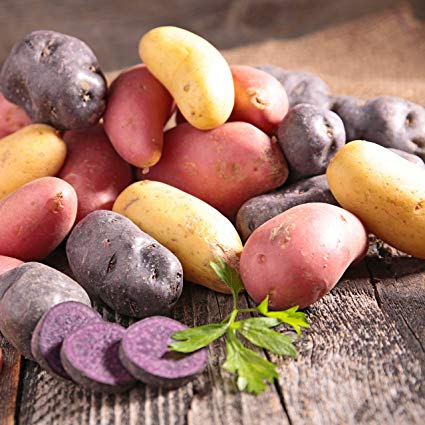Changing consumer food preferences and food security are two areas likely to influence future demand for potatoes and the direction of the potato industry and scientific community. To achieve global food security, some estimate crop yields must double by 2050. Because of their high yields (30 to 50 tons per acre are common in the Pacific Northwest), potatoes can be a cornerstone of global food security strategies. For example, the Chinese Academy of Sciences developed a strategic plan with potato as one key for food security. Potatoes provide a high amount of phytonutrients per acre, are affordable and storable—all important traits that enhance potato’s relevance for food security. One study of over 90 foods reported beans and potatoes provided the most nutrients per dollar. Affordability is important given studies showing low-income populations can struggle to afford healthy diets.
 In the absence of high-calorie additives, potatoes are a low-calorie food: One pound of potatoes provides about 440 calories, significant amounts of potassium and vitamin C, and many other vitamins, minerals and phytonutrients. They are a rich source of complex carbohydrates and are lower in simple sugars than other root vegetables including carrots, sweet potatoes and beets (USDA SR-21).
In the absence of high-calorie additives, potatoes are a low-calorie food: One pound of potatoes provides about 440 calories, significant amounts of potassium and vitamin C, and many other vitamins, minerals and phytonutrients. They are a rich source of complex carbohydrates and are lower in simple sugars than other root vegetables including carrots, sweet potatoes and beets (USDA SR-21).
The nutritional attributes of potatoes are more important than ever given we are amid a sea change in how health professionals and consumers think about diet. Increased scientific knowledge about the relationship between diet and health, combined with extensive media coverage and consumer education programs, will continue to shape dietary preferences. This is reflected in the millennial generation, who are well-known for their increased emphasis on nutrition. Generation Z (the generation just younger than millennials) constitutes over 25 percent of the population and will increasingly become the major retail demographic. Much has been written about characteristics of Gen Z, which include lifestyles revolving around health and wellness. They are reported to be adventurous eaters who eat fewer big meals, snack more and desire convenience, including ready-to-eat packaged foods that are healthy, tasty and visually appealing. They value freshness, organic foods, reduced sugar and natural ingredients over artificial.
What It Means for the Potato Industry
For plant breeders, the changing landscape offers new opportunities and urgencies. Consumer-desired traits may be increasingly important in future cultivars. While production-oriented traits like yield and disease resistance have been historical priorities and will remain vital, consumer-targeted traits like taste, appearance and nutritional value may be imperative for sales in the decades ahead. While potatoes already contain generous amounts of vitamins, minerals and phytonutrients, future cultivars can be further improved for many traits relating to nutritional and sensory quality.
An interesting question to ask is, To what extent will changing consumer dietary preferences impact potato growers and the food industry? Because potatoes are versatile and have a diverse selection of cultivars available, they are well-positioned to satisfy traditional and emerging consumer preferences. Moreover, such trends may present an opportunity for processors to use novel packaging and preparation methods that meet the desire for ready-to-eat meals, convenience and global flavors.
Changing consumer preferences don’t necessarily mean traditional potato products will be ignored, as seen by the fact that demand for french fries is growing domestically and globally. Indeed, some suggest there is not enough acreage or processing capacity to keep up with the anticipated demand. If the projection for continued growth is accurate, new cultivars with even greater yields may help offset acreage limitations. Perhaps demand for french fries has remained strong because, while sit-down family meals may be decreasing, relatively few fries are cooked at home—and because convenience and taste are attributes highly valued by younger generations.
If Generation Z food preferences are tilting away from traditional foods toward convenience, nutritional value, sensory qualities, smaller portions and novelty, then fresh-market specialty and baby potatoes may appeal to these consumers. Demographics that find white potatoes “boring” or “old-fashioned” may be attracted to visually striking specialty potatoes that possess unique flavor profiles. The color of yellow-fleshed potatoes is due to carotenoids that have various health-promoting effects including eye health and reduced risk of macular degeneration. The color of red, blue and purple potatoes is due to anthocyanins, which, along with other phenylpropanoids, can be present in high amounts in these potatoes—over 18 milligrams of anthocyanins per gram dry weight in some lines we’ve analyzed, which rival or surpass amounts found in better-known sources of anthocyanins such as plums, red cabbage and blueberries. Phenylpropanoids are desirable in the diet and are thought to promote cardiovascular health, possess anti-inflammatory and anti-cancer properties, along with numerous other health-promoting effects.
Baby potatoes are a good example of a product in line with trending consumer-desired traits. These are sometimes called new potatoes, little potatoes, baby bakers, minis or creamers. They are considered a premium product with superior taste, visual appeal and higher amounts of many phytonutrients than mature potatoes. They are sold in smaller quantities, have smaller portion sizes, and are suitable for tapas and shared plates. Baby potatoes do not require peeling, and the smaller size leads to shorter cooking times, conducive to changing lifestyles where people have fewer family sit-down dinners and spend less time cooking.
In terms of future demand, the potatoes’ ability to provide a high amount of calories and nutrition per acre suggests they will be important for food security. For consumers increasingly seeking non-traditional foods and alternative methods of preparation, specialty and baby potatoes may hold appeal.
Roy Navarre and Max Feldman are research geneticists with the USDA’s Agricultural Research Service. Both are based at the Irrigated Agriculture Research & Extension Center in Prosser, Wash.